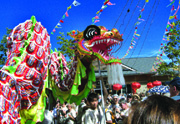Those who bring good news
Different faiths and cultures gather for the opening of the Fung Loy Kok Temple, a place of prayer and healing in rural Ontario
Article prepared by the Scarboro Missions Department of Interfaith Dialogue
July/August 2008
Return to Table of Contents
Print Article
 At the opening of the Taoist International Tai Chi Centre in Orangeville, Ontario, practitioners of the three religions of China (Taoist, Buddhist, and Confucian) wore red and blue robes and chanted ancient prayers on the steps. September 9, 2007.
At the opening of the Taoist International Tai Chi Centre in Orangeville, Ontario, practitioners of the three religions of China (Taoist, Buddhist, and Confucian) wore red and blue robes and chanted ancient prayers on the steps. September 9, 2007.
The beautiful red envelope arrived in the mail with a circular gold-stamped symbol, “Fung-Loy-Kok, Taoism International,” on the bottom left corner. It contained an invitation in English, French, and Chinese to attend the opening in Mono Mills and a dinner to follow. At the same time Louise Malnachuk, Scarboro missioner of 25 years, mostly spent working in Mainland China, noticed an exciting article in The Toronto Star announcing the grand opening of the Fung Loy Kok Temple in Mono Mills, Ontario. She read that the celebration would begin with a public gathering at Toronto City Hall with music, Tai Chi demonstrations, and welcome speeches by municipal and government officials.
A week later on a balmy, breezy Saturday afternoon in early September last year, three Catholic missionaries were among some 2,500 Tai Chi practitioners and friends, as well as interested Ontario residents. They were welcomed warmly and led into the grounds of a magnificent two-story Chinese temple. Thousands of colorful tiny flags flapped in the wind as Taoist, Buddhist, and Confucian practitioners dressed in red and blue robes chanted ancient prayers on the steps. The Chinese characters beneath the long gigantic roof read, “The Three Religions Temple” and inside there were the statued figures of Lao-Tsu, Confucius, and Buddha.
The three Scarboro missionaries sat and silently pondered the meaning behind a temple that honored the founders of three ancient Eastern faith traditions and wondered how this came to be, and how it came to be here in Mono Mills. This was the rugged hilly farmland of Irish immigrants from the famine of 1845-1850, where towns like Loretto and Orangeville indicated age-old tensions between Catholics and Protestants.
Bordering the Niagara escarpment and used by cross country hikers in summer and skiers in winter, this large rural area had for generations past sent priests, Brothers, and Sisters from their villages to serve in the Toronto Archdiocese and in communities of religious across Canada and overseas. The Cistercians had built a monastery in the 1980s to serve the need for stillness, contemplation, and retreat, and the Christian Brothers for years had their novitiate and house of formation there. You might say the Spirit was at work in that rustic environment.
“THE SIGN OF THE GOOD THAT MR. MOY PROPAGATED AND TAUGHT WHILE HE LIVED AND DREAMED AMONG US IN CANADA WAS THIS MAGNIFICENT GATHERING OF SO MANY PEOPLE, CULTURES, AND FAITHS AT THE TAI CHI CENTRE."
The opening ceremonies included speeches by officials of the international and Canadian Taoist Tai Chi Society and the Fung Loy Kok Institute of Taoism, as well as by local, provincial, and federal government representatives. This was followed by a tour of the buildings, then refreshments and later a magnificent Chinese dinner and barbeque served by hundreds of volunteers who had come from all over Canada and the United States to help prepare the grounds and do all that was needed to facilitate such an opening. These people from places like Texas, Alabama, British Columbia, and Quebec, chatted with the visitors about how all this came to be.
In the 1970s, Lin-Shin Moy came to Canada from Hong Kong and began teaching Tai Chi in Toronto and Montreal. When students began to master the art under Mr. Moy’s instruction he would encourage them to share the gift with others. There is a spiritual component to the art and practice of Tai Chi, but Mr. Moy’s genius was in teaching the physical practice for the sake of health and healing. Now some 40 years later, there is this magnificent structure with a temple, a building to practice and learn Tai Chi, and a residence for those with Parkinson’s or recovering from a stroke to benefit from the healing elements found in Tai Chi.
Certainly the sign of the good that Mr. Moy propagated and taught while he lived and dreamed among us in Canada was this magnificent gathering of so many people, cultures, and faiths at the Taoist International Tai Chi Centre.
It was almost 90 years ago, in November 1918, that our founder Fr. John Mary Fraser dreamed of evangelizing the Chinese people and began the China Mission, predecessor to Scarboro Missions, in Almonte, Ontario. Canadian Catholics, by your prayers and financial support over these 90 years, have enabled Scarboro missionaries to make Monsignor Fraser’s dream a reality. As the poetic line of Isaiah the prophet proclaims: How beautiful on the mountain tops are the feet of those, like Lin-Shin Moy, John Mary Fraser, and hopefully in our time thousands and thousands more, who bring good news.
Return to Table of Contents
Print Article


